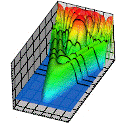Department of Physics and Astronomy: Publications and Other Research

Anthony F. Starace Publications
Document Type
Article
Date of this Version
7-11-2011
Abstract
By solving the two-active-electron time-dependent Schrödinger equation in an intense, ultrashort laser field, we investigate evidence of electron correlations in the high-order harmonic generation spectrum of helium. As the frequency of the driving laser pulse varies from 4.6 to 6.6 eV, the 13th, 11th, and 9th harmonics sequentially become resonant with the transition between the ground state and the isolated 2s2p(1P) autoionizing state of helium, which dramatically enhances these harmonics and changes their profiles. When each of the 9th and 13th harmonics are in resonance with this autoionizing state, there is also a low-order multiphoton resonance with a Rydberg state, resulting in a particularly large enhancement of these harmonics relative to neighboring harmonics. When the 11th harmonic is in resonance with the 2s2p(1P) autoionizing state, the 13th harmonic is simultaneously in resonance with numerous higher-energy autoionizing states, resulting in a competition between these two harmonics for intensity. These results demonstrate that even electron correlations occurring over a narrow energy interval can have a significant effect on strong-field processes such as harmonic generation.


Comments
Published in PHYSICAL REVIEW A 84, 013404 (2011); DOI: 10.1103/PhysRevA.84.013404 Copyright © 2011 American Physical Society. Used by permission.